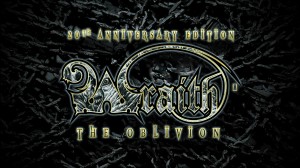Soulforging is one of the most distinctive features of the Underworld as seen in Wraith: The Oblivion. Wraiths with the right training and tools can turn their fellow wraiths’ bodies into the raw material for a wide range of crafting. Controversies among wraiths about the morality and utility of it all mark out important divisions within wraith society. But no matter how any individual feels about it, there are needs and wants that only the soulforges can fulfill. Clayton Oliver examines the nitty-gritty in these passages from the upcoming Book of Oblivion.
The Industrial Revolution passed the Underworld by for two reasons. The lesser reason, and the one critics use as a bludgeon, is the Artificers’ Guild’s deathgrip on thousands of years of history untouched by progress. Actually, the greater problem is the Underworld itself. Modern mining, refining, and production are deterministic systems: consistent inputs yield consistent outputs. On the other hand, raw materials among (or made of) the dead lack this predictability. Assembly lines don’t work well when every part requires individual treatment to accommodate properties only tenuously connected to physical qualities.
Additionally, one of soulforging’s immutable laws is that one soul yields one part. Most machines the Empire would like to mass-produce contain dozens, if not thousands, of parts. By way of example, a Colt Model 1911A1 – the archetypal example of a mass-produced firearm that still required extensive hand-fitting in its heyday – comprises 44 parts, from barrel, frame, and slide to springs, screws, and pins. That’s a minimum of 44 souls required to produce one weapon, not counting magazine parts, ammunition, and spares for components that sustain damage or wear. Underworld economics simply don’t support such an endeavor. This is why the Legions still rely on bladed weapons – simple machines – to arm the line troops while sifting the random relic supply chain for modern equipment to equip their elite units.
A character with appropriate history or connections can take a Crafts specialty in one of the major soulforging styles described above rather than just specializing in “generic” soulforging. Working in this style is optional for any job, but the smith can’t use or abandon a style in the middle of a job. Once declared, it’s in use for the entire process. Each style has an associated benefit and drawback.
Nhudric: During each stage of a soulforging job, the player may roll Strength in place of the specified Attribute. During working, accumulating three botches destroys the soul and gives the smith’s Shadow 3 temporary Angst. During finishing, increasing object Corpus requires only 2 successes. Breaking a Nhudric item requires a Strength rating 1 level higher than normal, cumulative with other modifiers (see Wraith 20, p. 320).
Zürcher: During each stage of a soulforging job, the player may roll Perception in place of the specified Attribute, but each roll takes 4 hours. During finishing, adding a specialty or decoration costs 1 less success. When visible, a Zürcher product applies -1 difficulty to any attempt its owner makes to impress or stand out visually.
Rose Island: During each stage of a soulforging job, the player may roll Manipulation in place of the specified Attribute. During each working and finishing stage, the first botch doesn’t add a crack, but each botch gives the smith’s Shadow 3 temporary Angst. When targeted by any power or manifestation of Oblivion, a product of the Rose Island cancels 2 successes, and any creature of Oblivion, including a Shadow-ridden wraith, suffers +1 difficulty on all rolls involving the item.
A crack in a soulforged item is not a physical defect but a spiritual one, a flaw induced by the smith’s failure to completely render down the soul into raw plasm. Cracks should not be crippling. They’re minor inconveniences intended to provide additional creepy flavor for things that are ultimately made of people and memories. The following list only skims the surface of possibilities; troupes should feel free to generate their own cracks based on what makes everyone at the table giggle nervously.
Compelling: The object is very interesting to one particular class of entities (Mourners, Ferrymen, Spectres, werewolves).
Fleeting: Whenever dropped, the object unerringly rolls or bounces into the most inconvenient place within five feet.
Lonely: If left unattended, the item gravitates toward other soulforged objects.
Magnetic: The bearer’s Shadow obsesses over the item.
Nihilistic: Whenever dropped, the object unerringly rolls or bounces five feet toward the nearest nihil large enough to swallow it.
Somnambulistic: Sometimes, when its owner Slumbers, the item travels to the closest other Slumbering wraith.
Transient: Supernatural creatures on the other side of the Shroud sometimes react to the object’s presence.
Vocal: The item emits faint anguished whimpers at socially-awkward times.
Vulnerable: The item seeks destruction. Whenever it suffers damage, the attacker rolls one extra die.
Weeping: The object occasionally seeps plasm that leaves faint salt-stains on corpus and relic garments.


I’ve always been a fan of Soulforging, both for its useful/creepy functionality as well as the dark story elements involved in the “raw materials” of the art. I’m excited to see new stuff to make my Artificers feel more like the grim artisans they are. I can say without a doubt that the Book of Oblivion is destined for my collection.
I love the extra flavor this adds as well as discussing different soulforging techniques.
What exactly IS this book about? Is it a players guide? A book about the underworld? I’ve tried looking around but nothing tells me
This may help:
https://forum.rpg.net/showthread.php?826101-Wraith-Upcoming-supplement-The-Book-of-Oblivion&p=21815387#post21815387